Nyungwe Forest National Park is one of the most biodiverse places in East Africa. Its dense forest and unique ecosystem host over 300 bird species, some of which are endemic to the area.
The park is situated in southern Rwanda and covers an area of 1,020 square kilometers. The forest ranges from 1,600 to 2,950 meters above sea level, making it the ideal habitat for a variety of birdlife.
In this article, we will explore some of the most fascinating birds found in Nyungwe Forest National Park, which draws birdwatchers from all corners of the world to Rwanda.
1. Handsome Spurfowl
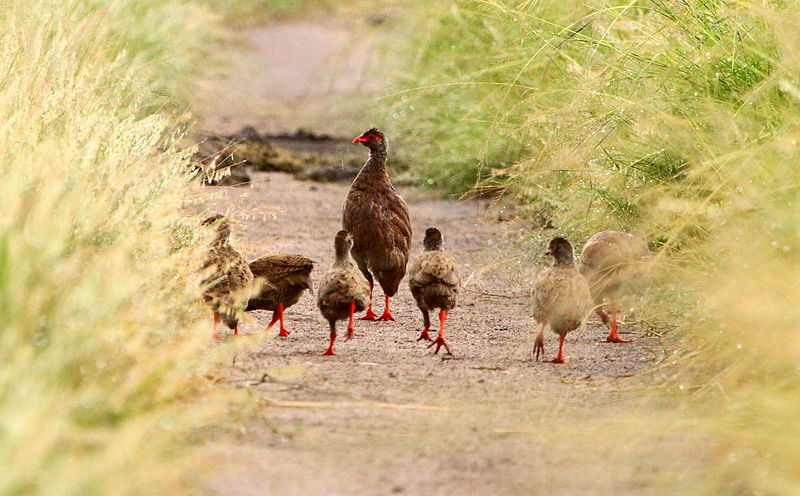
The Handsome Spurfowl is a beautiful bird found in forests across Africa. It has reddish-brown plumage, a grey head and red bill and legs that give it an attractive appearance.
Its eyes have brown irises with bare red orbital skin around them, while its underside is rufous grey. Both sexes are similar in size but the female may be slightly smaller than the male.
The young birds have duller feathers compared to adults. This species typically feeds on seeds, insects, fruits and other small creatures found near ground level – making it quite easy for people to spot when out walking or wildlife watching.Scientific classification:
| Kingdom | Animalia |
| Phylum | Chordata |
| Class | Aves |
| Order | Galliformes |
| Family | Phasianidae |
| Genus | Pternistis |
| Species | P. nobilis |
Also Featured In: Uganda Birds Species, Endemic Birds of Uganda that You Need to Know
2. Regal Sunbird
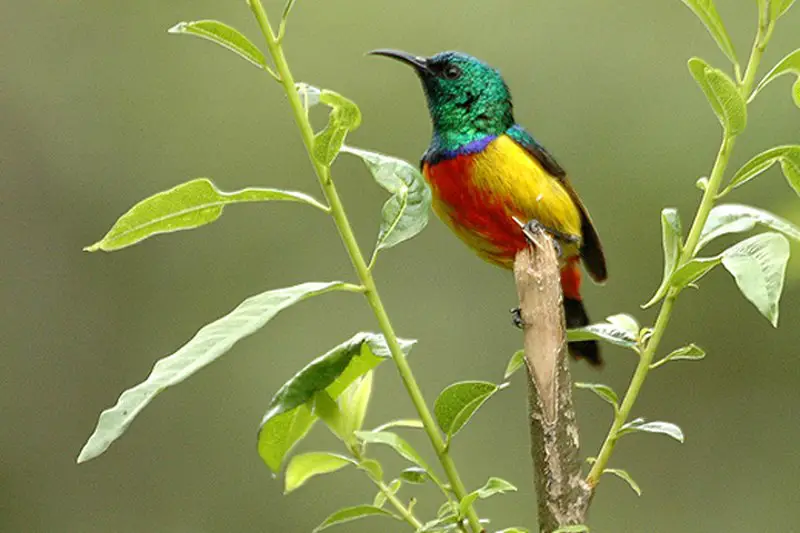
The Regal Sunbird is a small and elegant species of bird that can be found in the Albertine Rift montane forests.
The adult males have an iridescent golden-green coloured head, dark wings and tail, as well as a boldly marked red & yellow breast and belly.
Females are less colourful but still stunning with their dull olive upper parts, paired alongside faint streaks of yellow on the underside.
These sunbirds feed mainly off nectar from wild flowers which they get using their long curved bills; however they also eat insects for additional nutrients.
They tend to stay close to flowering shrubs or trees whilst singing beautiful songs throughout the day – making them one of nature’s most treasured creatures.Scientific classification:
| Kingdom | Animalia |
| Phylum | Chordata |
| Class | Aves |
| Order | Passeriformes |
| Family | Nectariniidae |
| Genus | Cinnyris |
| Species | C. regius |
3. Purple-Breasted Sunbird
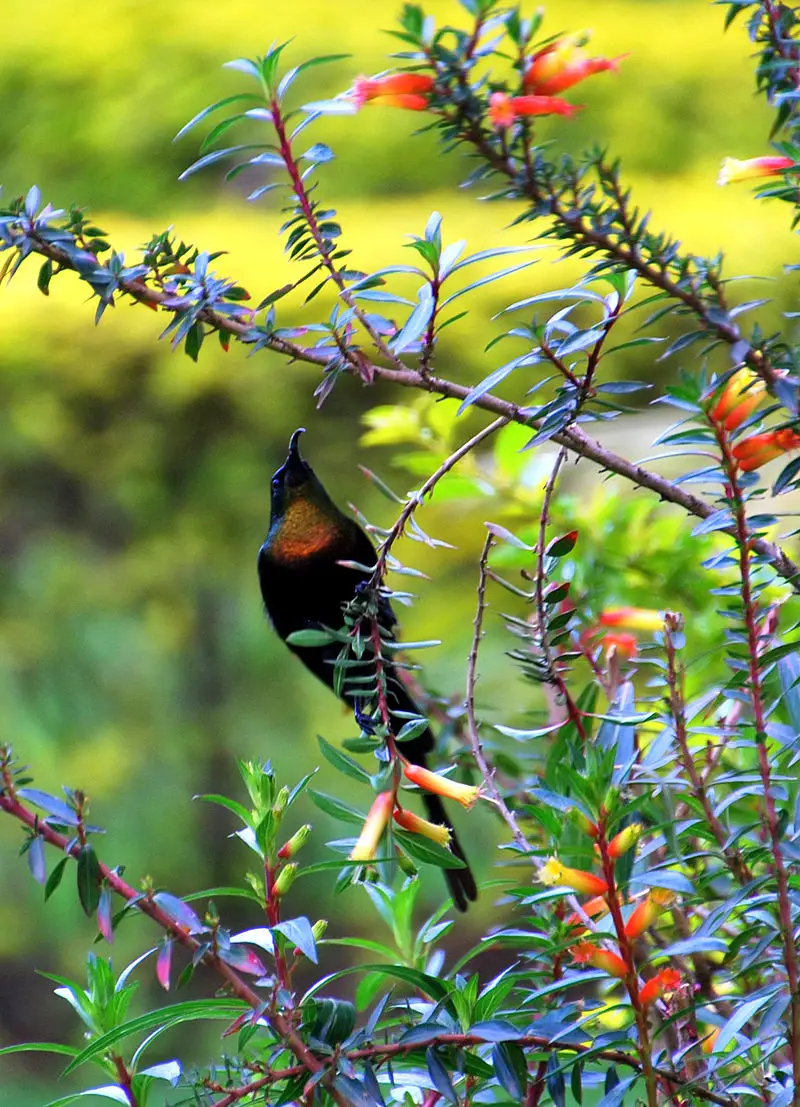
The beautiful Purple-breasted Sunbird is a species of bird found in Burundi, Democratic Republic of the Congo, Rwanda and Uganda. It belongs to the family Nectariniidae which are known for their attractive colors.
The male sunbirds have an iridescent purple throat and breast with a light brown head and back while females tend to be duller in coloration.
These birds feed mainly on nectar from flowers but also eat insects such as beetles and caterpillars when available.
They can often be seen perched atop tall trees searching for food or hovering near flowering plants collecting nectar from them using their long curved bills.
Their bright plumage makes them easily recognizable amongst other birds making it easy for us to appreciate their beauty.Scientific classification:
| Kingdom | Animalia |
| Phylum | Chordata |
| Class | Aves |
| Order | Passeriformes |
| Family | Nectariniidae |
| Genus | Nectarinia |
| Species | N. purpureiventris |
Also Featured In: Top Birds of Rwanda,
4. Blue-Headed Sunbird
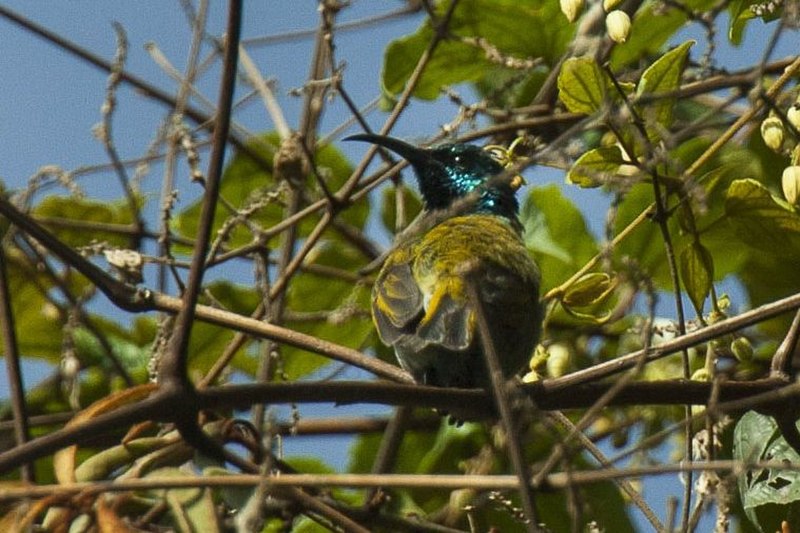
The Blue-Headed Sunbird is a beautiful species of bird found in Burundi, the Democratic Republic of Congo, Rwanda and Uganda.
It belongs to the family Nectariniidae and has striking blue head feathers with contrasting yellow underbelly plumage.
The sunbird also features an impressive long pointed beak which it uses for feeding on nectar from flowering plants.
Additionally, they are known to feed on insects as well due to their active lifestyle – often seen flying rapidly between flowers while hovering like hummingbirds.
Their unique colouration makes them stand out amongst other birds in its range; making this incredible bird one that should not be missed when encountered.Scientific classification:
| Kingdom | Animalia |
| Phylum | Chordata |
| Class | Aves |
| Order | Passeriformes |
| Family | Nectariniidae |
| Genus | Cyanomitra |
| Species | C. alinae |
5. Dusky Crimsonwing
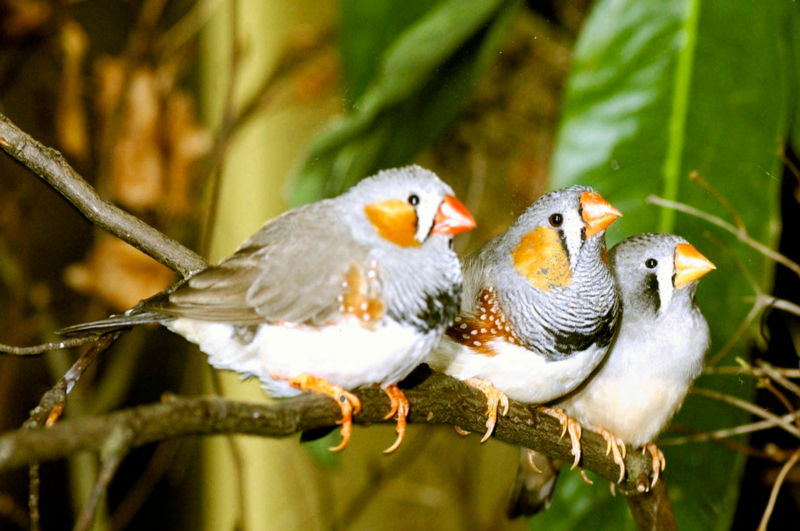
The Dusky Crimsonwing is a beautiful species of estrildid finch found in Africa. It has an estimated global range of 78,000km2 and can be found mainly in the Albertine Rift montane forests.
The bird’s binomial name commemorates English explorer Frederick John Jackson. Its plumage is quite unique with its feathers ranging from dark brown to rufous-red on the back and wings, while it’s belly is white or greyish-white along with black streaking throughout its body.
This vibrant coloured creature also features a red eye ring which adds immensely to its beauty when seen up close.
As for dieting habits, this species likes to feed on small insects as well as fruits like berries that are natively grown in their habitat area.
All these traits combined make them one of nature’s most exquisite creatures whose presence will surely leave anyone mesmerized.Scientific classification:
| Kingdom | Animalia |
| Phylum | Chordata |
| Class | Aves |
| Order | Passeriformes |
| Family | Estrildidae |
| Genus | Cryptospiza |
| Species | C. jacksoni |
6. Yellow-Eyed Black Flycatcher
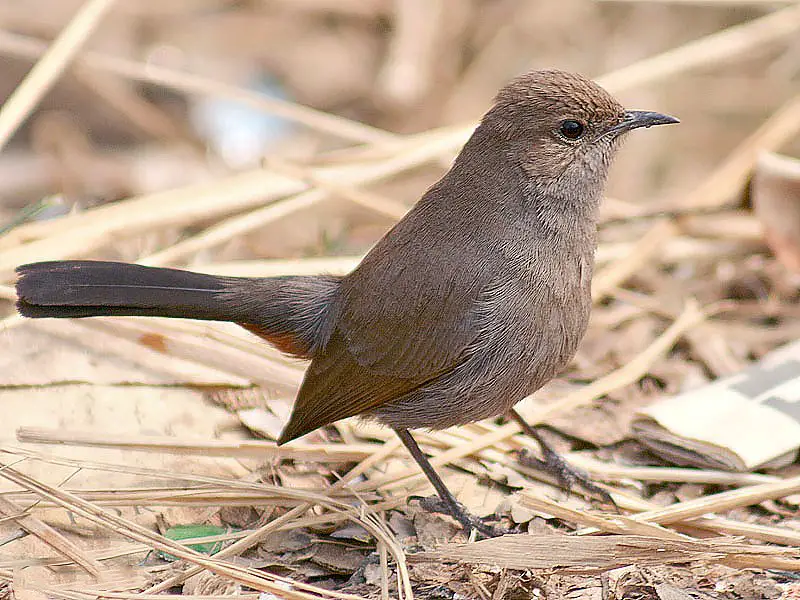
The Yellow-eyed black flycatcher is a small, passerine bird native to the Albertine Rift montane forests. It belongs to the genus Melaenornis and family Muscicapidae.
This beautiful bird has yellow eyes with white eyebrows that contrast sharply against its jet black plumage, giving it an eye-catching look.
Its beak is short and stubby while its legs are relatively long compared to other birds of similar size; they have been known to use them for pouncing on their insect prey.
The diet of this species mainly consists of insects such as flies, beetles or caterpillars but can also include some fruits depending on what’s available in their environment.
As habitat destruction continues across the world, these beautiful birds may become more vulnerable which makes conserving their natural habitats all the more importantScientific classification:
| Kingdom | Animalia |
| Phylum | Chordata |
| Class | Aves |
| Order | Passeriformes |
| Family | Muscicapidae |
| Genus | Melaenornis |
| Species | M. ardesiacus |
7. Red-Faced Woodland Warbler
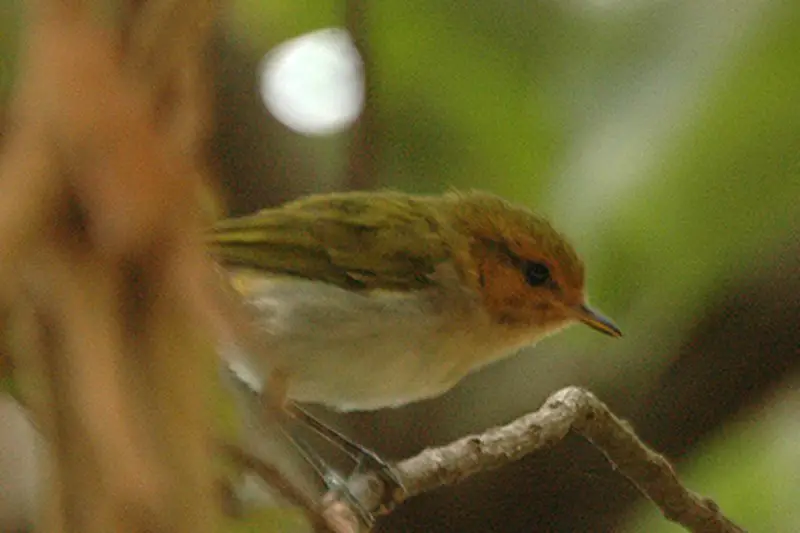
The Red-faced Woodland Warbler is a species of leaf warbler found in the family Phylloscopidae. It is closely related to two other species, the Yellow-throated Woodland Warbler and Laura’s Woodland Warbler.
These birds are native to East Africa, mostly inhabiting parts of Uganda, DR Congo and South Sudan. They nest among trees or shrubs near water sources like rivers or streams.
The males have bright red faces with white throats surrounded by yellowish feathers on their lower cheeks while females possess duller plumage than males but still display faint reddish coloring on their heads and chests.
During breeding season they sing melodious songs that can be heard from quite far distances during sunrise hours when most activity takes place around nesting sites.Scientific classification:
| Kingdom | Animalia |
| Phylum | Chordata |
| Class | Aves |
| Order | Passeriformes |
| Family | Phylloscopidae |
| Genus | Phylloscopus |
| Species | P. laetus |
8. Albertine Owlet
The Albertine owlet is a small bird native to the montane forests of the Albertine Rift. It belongs to the family Strigidae and some authorities classify it as a subspecies of African barred owlet, while others such as BirdLife consider it its own species.
The two birds are very similar in appearance; both have white eyebrows, dark eyes and brown streaked feathers with buff edges on their wings and tail.
They measure between 22–24 cm in length and weigh around 86–99 gm. Their diet consists mostly of insects but they may also eat frogs, lizards or even small mammals.
These nocturnal birds usually hunt alone by perching on branches then flying out quickly after prey has been spotted below them.
Due to deforestation caused by human activities these beautiful creatures are now endangered so we should do our best to protect their habitats for future generations.Scientific classification:
| Kingdom | Animalia |
| Phylum | Chordata |
| Class | Aves |
| Order | Strigiformes |
| Family | Strigidae |
| Genus | Glaucidium |
| Species | G. albertinum |
9. Kungwe Apalis
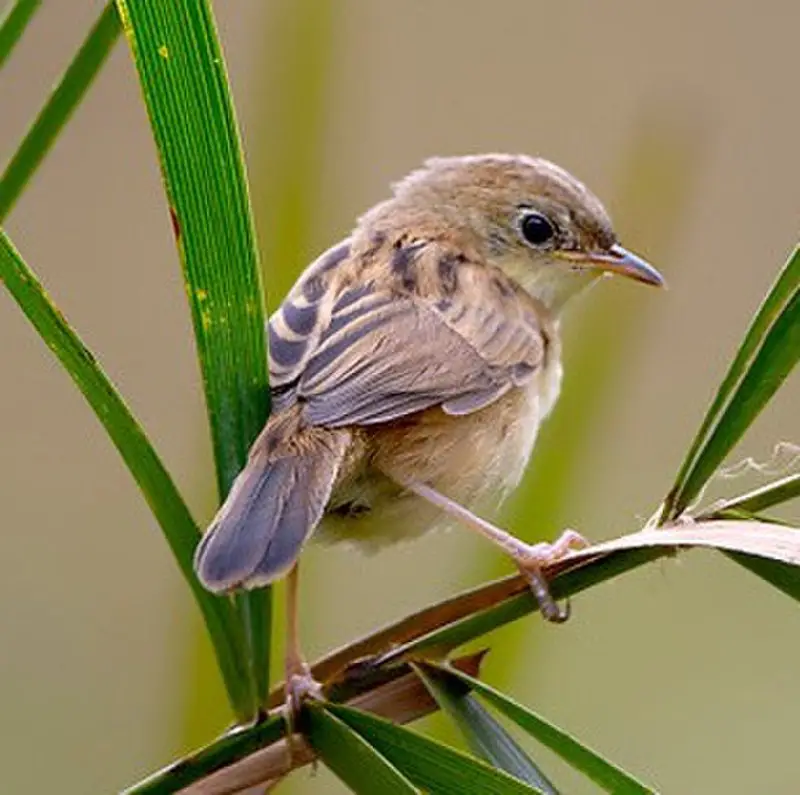
The Kungwe apalis is a species of bird in the Cisticolidae family. Found in Burundi, Democratic Republic of Congo, Rwanda and Tanzania, it prefers habitats such as subtropical or tropical dry forests and moist montane forests.
Unfortunately this unique little creature is threatened by habitat loss due to human activities such as logging and deforestation that reduce their natural range.
It was previously classified as a subspecies of Buff-throated Apalis but has since been reclassified into its own distinct species.
The Kungwe apalis stands out with its bright yellow forehead interspersed with black stripes on either side while the rest of its body displays various shades of browns and greys along with white spots near the wings.Scientific classification:
| Kingdom | Animalia |
| Phylum | Chordata |
| Class | Aves |
| Order | Passeriformes |
| Family | Cisticolidae |
| Genus | Apalis |
| Species | A. argentia |
10. Mountain Masked Apalis
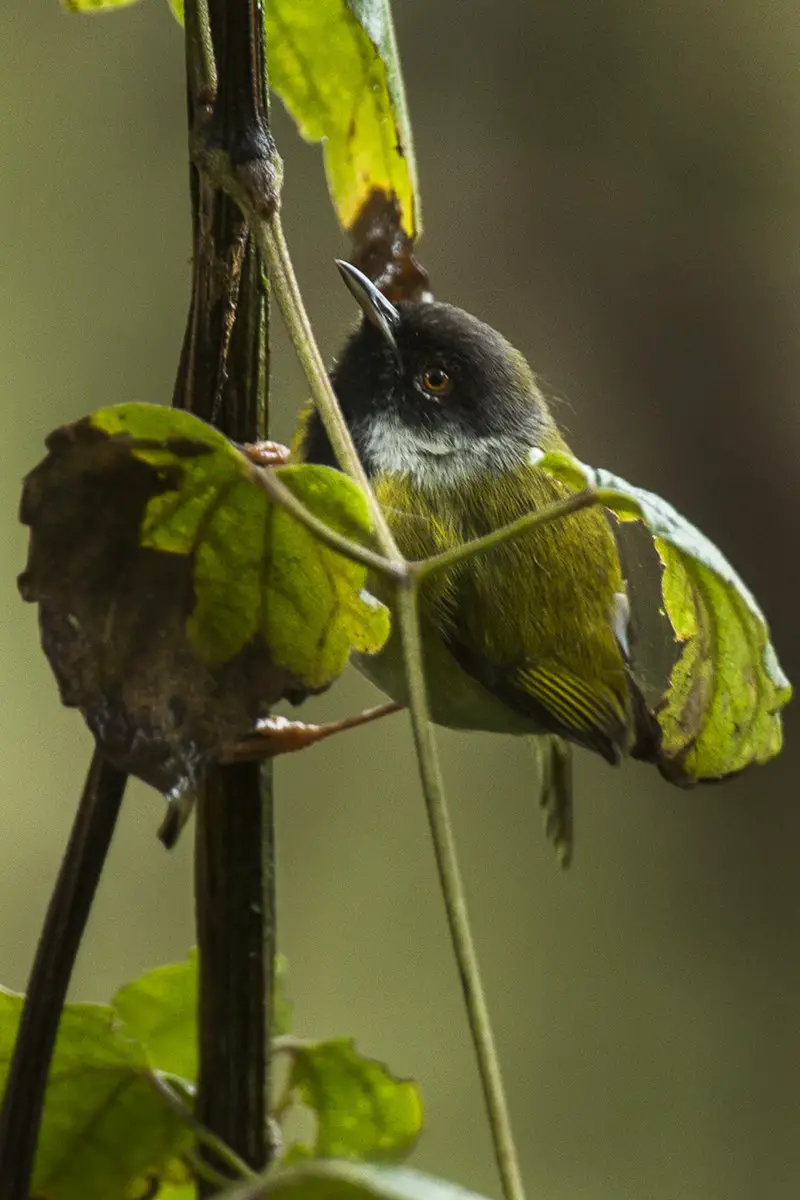
The Mountain masked apalis, or black-faced apalis, is a species of bird from the family Cisticolidae. It can be found in Albertine Rift montane forests and was first described back in 1902.
This small but striking bird has dark gray upperparts with white markings on its wings and tail feathers, as well as pale gray underparts adorned with two bold black stripes across its chest.
The most distinctive feature of this species is the jet-black mask that frames its eyes like an eye patch – making it easily identifiable amongst other birds within their range. Its diet consists primarily of insects but they will feed on fruits when available too.
They are fairly common throughout their habitat and make delightful additions to any outdoor space where they can be spotted singing sweetly while flitting between trees and shrubs searching for food sources.Scientific classification:
| Kingdom | Animalia |
| Phylum | Chordata |
| Class | Aves |
| Order | Passeriformes |
| Family | Cisticolidae |
| Genus | Apalis |
| Species | A. personata |
11. Rockefeller’s Sunbird

Rockefeller’s sunbird is a species of bird found in the Albertine Rift in eastern Democratic Republic of Congo. It belongs to the Nectariniidae family and Cinnyris genus, which was formerly part of the Nectarinia genus.
This unique species has white-tipped tail feathers with striking bronze upperparts and yellowish underparts that make it stand out from its peers.
Its diet consists mainly of nectar from flowers as well as small insects like spiders, ants and larvae for protein intake.
Rockefeller’s sunbird is dependent on montane forests for its habitat; however some areas have been affected by deforestation due to human activities such as logging or subsistence agriculture leading to declines in population numbers.
Conservation efforts are needed now more than ever if this beautiful creature is going to survive into future generationsScientific classification:
| Kingdom | Animalia |
| Phylum | Chordata |
| Class | Aves |
| Order | Passeriformes |
| Family | Nectariniidae |
| Genus | Cinnyris |
| Species | C. rockefelleri |
12. Stripe-Breasted Tit
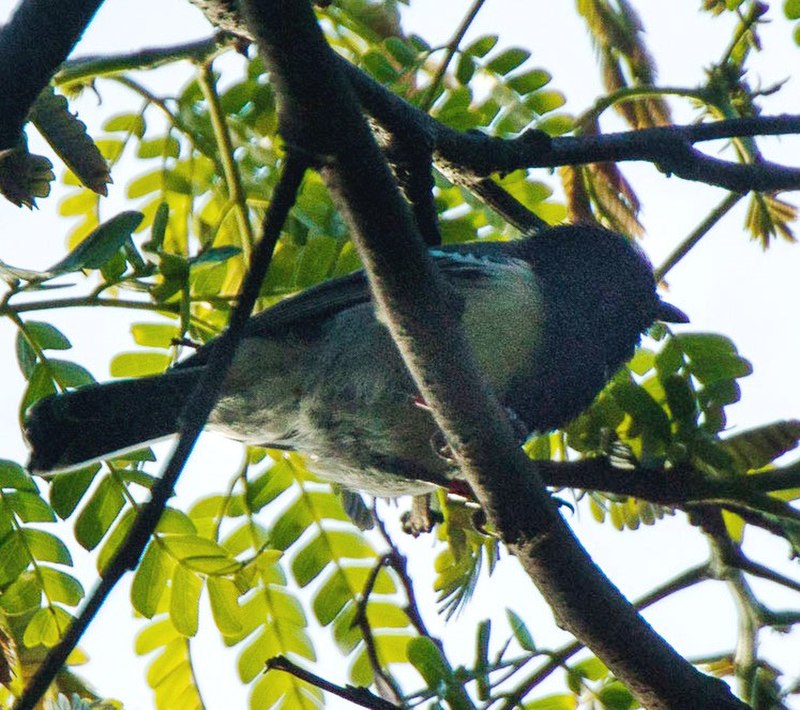
The Stripe-breasted Tit is a species of bird found in four countries: Burundi, Democratic Republic Congo, Rwanda and Uganda.
It inhabits subtropical or tropical moist montane forests where it can be seen foraging for food on the ground among foliage.
This small but beautiful bird has an unmistakable appearance with black and white stripes across its chest. Its head is also covered by delicate black feathers that contrast nicely against its bright yellow eyes.
The Stripe-breasted Tit was formerly classified within the genus Parus until a molecular phylogenetic analysis revealed that it should actually belong to Melaniparus instead – thus requiring a separate scientific name.
Despite this classification change however, one thing remains true; these birds are truly captivating creatures who deserve our utmost respect and protection from any potential threats they may face in their natural habitats.Scientific classification:
| Kingdom | Animalia |
| Phylum | Chordata |
| Class | Aves |
| Order | Passeriformes |
| Family | Paridae |
| Genus | Melaniparus |
| Species | M. fasciiventer |
13. Grauer’s Swamp Warbler
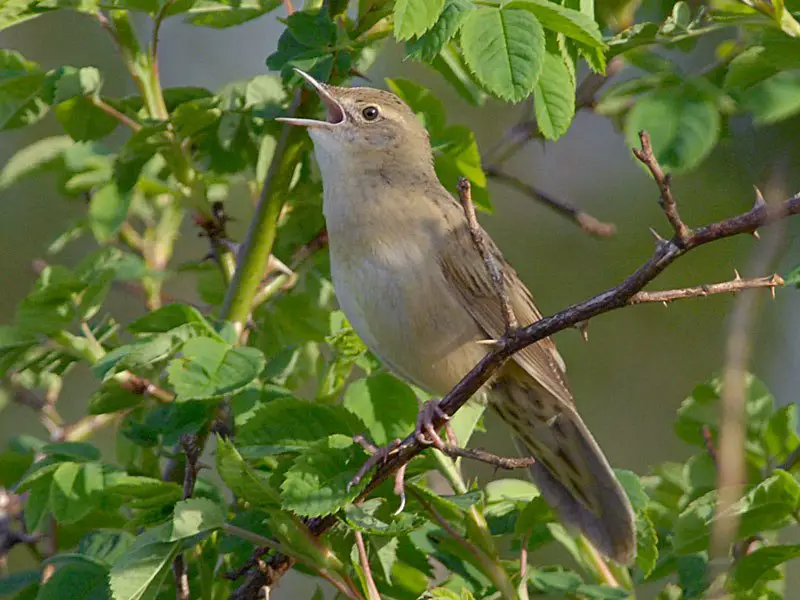
Grauer’s swamp warbler is an Old World warbler found in Burundi, Democratic Republic of the Congo, Rwanda and Uganda.
It enjoys freshwater lakes and marshes as its natural habitats but unfortunately these are threatened due to habitat loss.
Endemic to the Albertine Rift, they inhabit montane swamps above 1900m elevation.
Investigations have been carried out into their diet which consists mainly of insects such as ants and beetles with some spiders too.
They may also be seen foraging on the ground or perched on vegetation near water sources.
The Grauer’s Swamp Warblers are relatively small birds that breed during summer months from June until September in Central Africa where a single egg is laid in a cup-shaped nest suspended between two reeds over water bodies.Scientific classification:
| Kingdom | Animalia |
| Phylum | Chordata |
| Class | Aves |
| Order | Passeriformes |
| Family | Locustellidae |
| Genus | Bradypterus |
| Species | B. graueri |
14. Dwarf Honeyguide
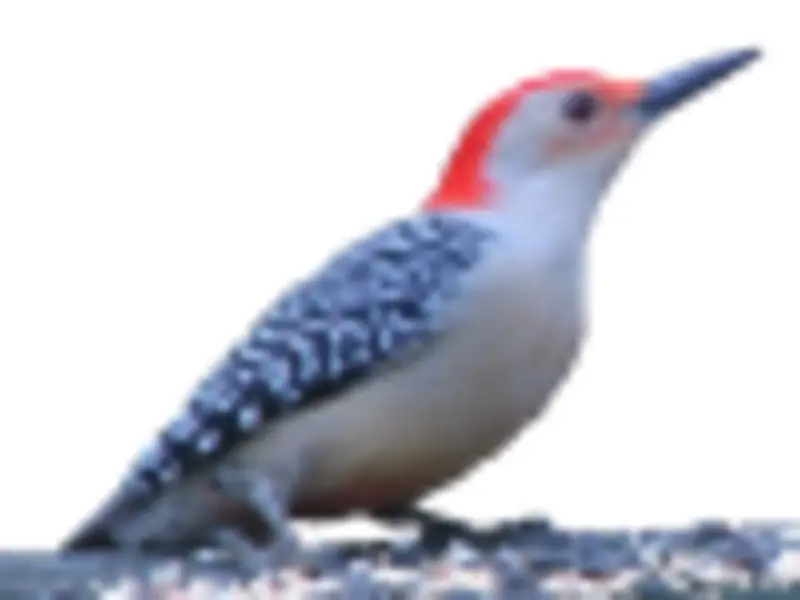
The Dwarf honeyguide is a small bird endemic to the Albertine Rift montane forests. It belongs to the family Indicatoridae, which includes other species of Honeyguides.
This particular species is threatened by habitat loss and uses brood parasitism as an adaptation for survival. As a result, it will lay its eggs in another host’s nest so that they can be incubated and fed by their foster parents.
These birds have adapted to survive in harsh conditions due to human encroachment on their natural habitats, but conservation efforts are still necessary if this species is going to continue thriving into future generations.Scientific classification:
| Kingdom | Animalia |
| Phylum | Chordata |
| Class | Aves |
| Order | Piciformes |
| Family | Indicatoridae |
| Genus | Indicator |
| Species | I. pumilio |